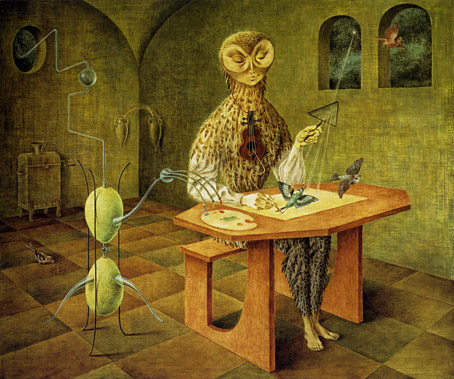The Creation of the Birds (1957) by Remedios Varo.
• “I think my music is very modern and very old. Together.” Sandy Robertson interviewed Popol Vuh’s Florian Fricke for Sounds in 1981. The Fricke-directed Sei Still Wisse ICH BIN referred to in the feature may be viewed here. Further Vuh-ing: Popol Vuh on Beat Club, 1971; a news clip of the group from the same year; a filmed improvisation from around the same time (Florian still had his Moog); and the group miming to recorded music from a year or two later.
• More Rammellzee (see last week): Gothic Futurism, a video collage based on Rammellzee’s treatise of the same name. Probably the only place you’ll ever see Rammellzee, the late Glenn Branca and art historian Kenneth Clark thrown together.
• After releasing 5 albums, Disjointed Oddities And Other Such Things is the first EP of “odd strange electronics, psych, Radiophonics, drone and quirky folk” by Keith Seatman.
• Alina Cohen on Remedios Varo, a Spanish Surrealist painter whose work has been receiving increased attention in recent years but whose life remains under-examined.
• More German music: “I grew up in total ruins”—Irmin Schmidt of Can on LSD, mourning and musical adventures.
• Mixes of the week: FACT mix 655 by Matthewdavid, and The Monday Is Okay mix by JQ.
• Olivia Laing, Sarah Wood and Philip Hoare discuss Modern Nature by Derek Jarman.
• National Geographic has digitized its collection of 6,000+ vintage maps.
• At Bandcamp: The Transcendental Sound of Moroccan Gnawa Music.
• Joe Fletcher on the nightmarish dream logic of Bruno Schulz.
• Levi Stahl on the mind of Donald E. Westlake.
• Affenstunde (1970) by Popol Vuh | Toy Planet (1981) by Irmin Schmidt & Bruno Spoerri | Adithaim (2005) by The Cracow Klezmer Band


I’ve been a huge fan of Remedios Varo’s work ever since I caught the exhibition of her work at the National Museum of Women in the Arts here in Washington DC back in 2000. I do prefer her to Carrington or Kahlo. It’s funny how all the various ideologies want to claim her when she contains them all and much more. Wakefield Press has a collection of her writings on their schedule to be released in November.
http://wakefieldpress.com/varo_dreams.html
Yes, I was wary of pigeonholing her as a Surrealist (especially when the term became increasingly narrow label under Breton) but it’s a convenient shorthand. Leonora Carrington seemed more committed to the Surrealist project whereas Varo is like Leonor Fini, in a field of her own.
I saw some mention of the Wakefield book earlier. Would be nice if someone could translate one or more of Leonor Fini’s novels (assuming they’re worth translating). With all this reappraisal happening they may be next.